The Luxurious Look of Russian
Lacquer Boxes
by Bob Brooke
Russian lacquer art developed from the art of icon painting which came
to an end with the collapse of Imperial Russia. The icon painters, who
previously had been employed by supplying not only churches but people's
homes, needed a way to make a living. Thus, the craft of making
papier-mache decorative boxes developed. They lacquered the boxes, then
artists hand painted them, often with scenes from folk tales, such as
the tale of the Firebird, or of Prince Igor, or of Swan Lake.
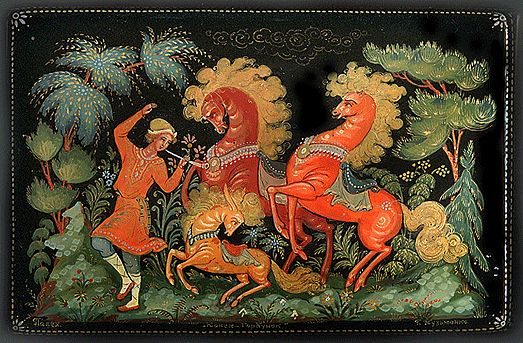
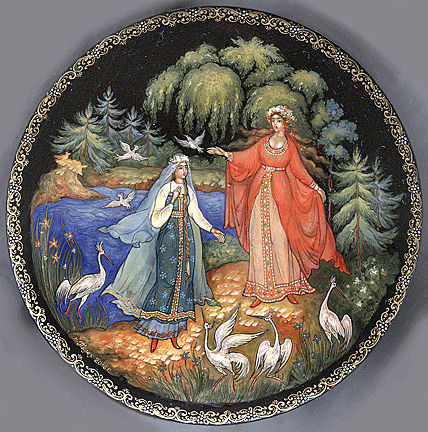 Princesses
dance, czars scowl, knights do battle, horses fly, suns smile, Father
Frost puffs icy wind, and lovers embrace on glossy black backgrounds of
lacquered papier-mache, surrounded by spectacular borders of gold
filigree. Vivid reds and yellows dominated these scenes, with greens and
blues and ivories typically reserved for highlights and details. Princesses
dance, czars scowl, knights do battle, horses fly, suns smile, Father
Frost puffs icy wind, and lovers embrace on glossy black backgrounds of
lacquered papier-mache, surrounded by spectacular borders of gold
filigree. Vivid reds and yellows dominated these scenes, with greens and
blues and ivories typically reserved for highlights and details.
In finer boxes, artists often applied paint over gold or silver,
producing a luminescence reminiscent of traditional Russian icon
painting. The brushwork could be astonishingly intricate and detailed
and beautifully rendered in the kind of stylized realism associated with
European miniature paintings of the Middle Ages.
Artists in four villages—Fedoskino, Palekh, Kholui and Mstyora—made
these lacquered boxes. All except Fedoskino lie in the Vladimir-Suzdal
Principality, Ivanovo region of central Russia, and have been deeply
rooted in the 17th- to 19th-century icon painting tradition, which
lasted until the Russian Revolution of1917.
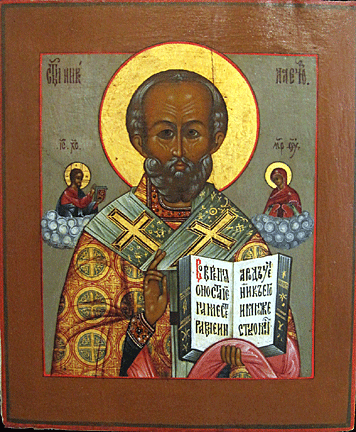 The
latter two villages, both north of Moscow, were for centuries an
important home of traditional Russian icon painters, whose gilded
portraits of-melancholy saints and dolorous Madonnas were the essential
art form of czarist Russia. After the 1917 revolution, however, the new
Bolshevik government banned religious art, and the icon makers turned to
legends and folk tales and poems for their subjects. The
latter two villages, both north of Moscow, were for centuries an
important home of traditional Russian icon painters, whose gilded
portraits of-melancholy saints and dolorous Madonnas were the essential
art form of czarist Russia. After the 1917 revolution, however, the new
Bolshevik government banned religious art, and the icon makers turned to
legends and folk tales and poems for their subjects.
The papier-mache process, used to make these lacquer boxes, took about
six weeks to ensure that it wouldn’t warp, didn’t expand and contract
with temperature, and had a linseed oil base which rendered it
impervious to moisture. The papier-mache, itself, consisted of cardboard
covered with flour paste which workers then shaped, coated with warm
linseed oil, planed, and sanded. Artists applied clay, oil, and soot as
an
undercoating that they smoothed with a pumice stone, then lacquered and
primed in preparation for the artist.
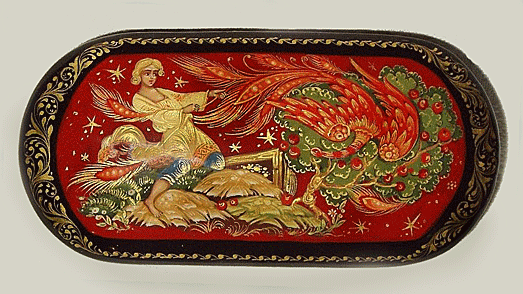
Although black was the most common color for a background, artists also
used red, blue, green, and white backgrounds. Red was the most
challenging background to paint on a lacquer box because the other
colors don’t come forward. By contrast, a black background wasn’t only
dramatic, but also the easiest color with which to work.
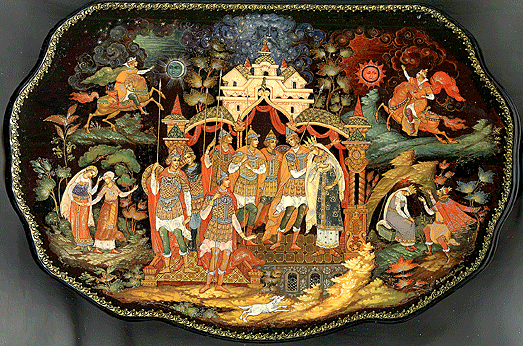
History of Lacquer Boxes
The crafting of Russian lacquer boxes dates back to the 18th century and
the reign of Peter the Great. Originally used for holding snuff, these
boxes have evolved into many different shapes and sizes for holding
things like jewelry and money.
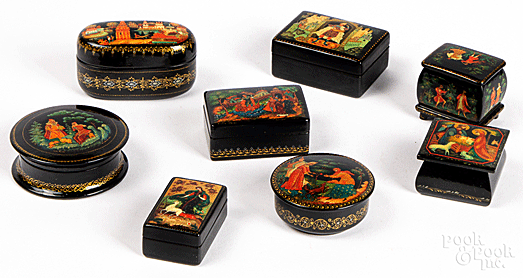
Originally, the making of lacquer ware began in China and later spread
throughout Asia. In 1721, Peter the Great instructed workers to adorn
the Monplaisir Palace in St. Petersburg with 94 lacquered tiles. Russian
artists then painted these tiles and eventually the skilled Russian
artisans began to devote more attention to the technique of lacquer
painting.
By the mid 18th century, tobacco became affordable for ordinary people,
and the need for a box to hold the snuff became necessary. The wealthy
had stored their snuff in boxes made out of ivory. gold, and other
precious materials, but inexpensive lacquer boxes became a good
alternative for poorer folk.
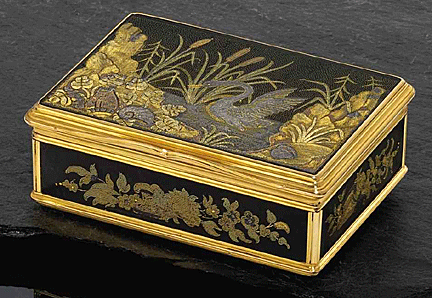 While
traveling to Germany, Pyotr Korobov came across the factory of Johann
Heinrich Stobwasser in Braunschweig. Korobov became intrigued by the
lacquer items produced there and took supplies back home to the village
of Fedoskino to make his own. The year was 1795. While
traveling to Germany, Pyotr Korobov came across the factory of Johann
Heinrich Stobwasser in Braunschweig. Korobov became intrigued by the
lacquer items produced there and took supplies back home to the village
of Fedoskino to make his own. The year was 1795.
Decorated snuftboxes, made in Fedoskino in great quantities in the early
19th century by Piet:Vasieiievich Lukutin, were probably the finest of
all old Russian lacquer boxes but today are extremely rare. Lukutin's
boxes were durable, but the processes he employed in producing a perfect
material for his lacquer work from compressed sheets of cardboard were
lengthy and painstaking. Evidently Lukutin realized that the success of
"japanning" depended upon the quality of the papier-mache itself. He
gave his boxes numerous coatings of lacquer laboriously hand polishing
them between applications. He obtained a fine patina by first soaking
his boxes in vegetable oil and hardening them in low-heat ovens for a
long time.
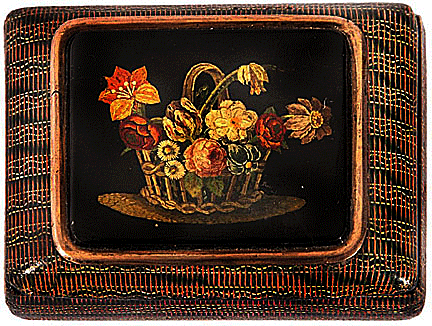 Artists
decorated the earliest Lukutin boxes with themes similar to those used
by English and German decorators at the time. They used landscapes and
skylines as well as genre subjects. They also decorated boxes with
mother-of-pearl. Toward the middle of the 19th century, they began
decorating the boxes with Russian folk motifs. From 1828 on, the Lutkin
family marked the boxes with the Imperial eagle and the various initials
of the members of the family in charge of the factory at the time. They
continued to run the business successfully until it closed in 1904. Artists
decorated the earliest Lukutin boxes with themes similar to those used
by English and German decorators at the time. They used landscapes and
skylines as well as genre subjects. They also decorated boxes with
mother-of-pearl. Toward the middle of the 19th century, they began
decorating the boxes with Russian folk motifs. From 1828 on, the Lutkin
family marked the boxes with the Imperial eagle and the various initials
of the members of the family in charge of the factory at the time. They
continued to run the business successfully until it closed in 1904.
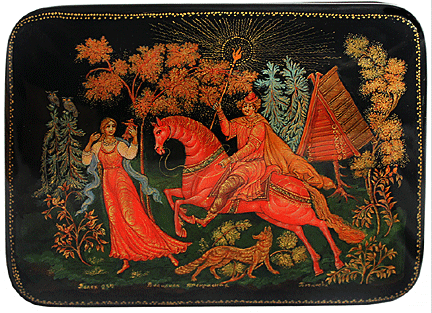 The
styles of decorations of papier-mache boxes in the village of Palekh
differed from those decorated at the old Lutkin works. In 1917 some of
the artists and craftsmen of the lacquer industry formed cooperatives
and revived the art before it became lost. But it wasn’t until Ivan
Golikov applied icon painting techniques to lacquered papier-mache in
1922 that many of the icon painters of pre-Revolutionary days began work
in Palekh decorating lacquer boxes. Painted in egg tempera rather than
the oils used in Fedoskino, the Palekh
style is fanciful and somewhat less realistic than those of the original
village. The artists of The
styles of decorations of papier-mache boxes in the village of Palekh
differed from those decorated at the old Lutkin works. In 1917 some of
the artists and craftsmen of the lacquer industry formed cooperatives
and revived the art before it became lost. But it wasn’t until Ivan
Golikov applied icon painting techniques to lacquered papier-mache in
1922 that many of the icon painters of pre-Revolutionary days began work
in Palekh decorating lacquer boxes. Painted in egg tempera rather than
the oils used in Fedoskino, the Palekh
style is fanciful and somewhat less realistic than those of the original
village. The artists of
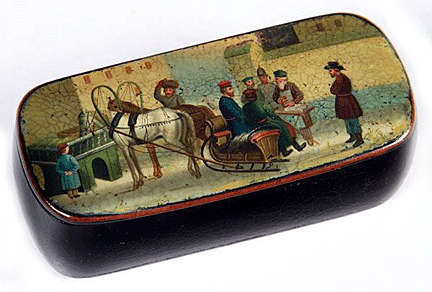 both
Kholui and Mstyora also used egg tempera paint. both
Kholui and Mstyora also used egg tempera paint.
Another difference was the subject matter they painted and how they
painted it. Fedoskino was known for realistic impressionistic scenes,
while the other three focused on relic paintings that were less
realistic. Originally, Palekh made relic paintings for the rich: Kholuy
and Mstyora made relic paintings for the middle class and poor.
Fedoskino
The village of Fedoskino, located not far from Moscow on the banks of
the Ucha River, is the oldest of the four art centers of Russian lacquer
miniature painting on papier-mache, which has been practiced there since
1795. Its artists practice a style of remarkably realistic
impressionistic people and scenes using both opaque and transparent oil
paint applied in a three-part process, providing higher depth and
detail.
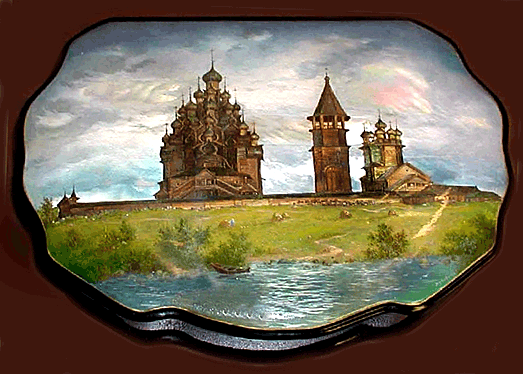
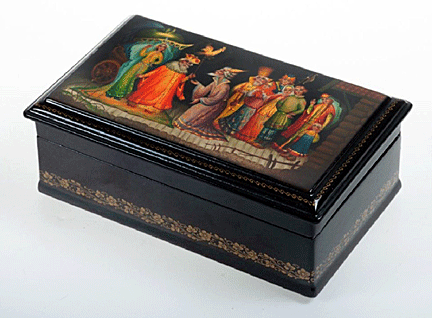 The
earliest versions of Fedoskino lacquer boxes were trademarked "Petr
Lukutin," who inherited the factory in 1828. Lukutin's son Alexander
then inherited the factory in 1843, and Lukutin remained the trademark
until 1904 when the factory closed. A group of craftsmen re-opened the
factory in 1910 and called it Fedoskino Artel. The
earliest versions of Fedoskino lacquer boxes were trademarked "Petr
Lukutin," who inherited the factory in 1828. Lukutin's son Alexander
then inherited the factory in 1843, and Lukutin remained the trademark
until 1904 when the factory closed. A group of craftsmen re-opened the
factory in 1910 and called it Fedoskino Artel.
Fedoskino artists had an unsophisticated style, full of rosy-cheeked
maidens and dewy-eyed animals, although its masters executed good copies
of popular 19th-century portrait paintings.
Palekh
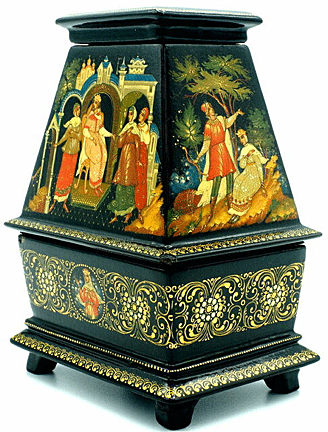 Palekh
boxes appeared at the beginning of the 20th century and focused on relic
paintings, almost always on a black background. Along with historical
subjects, Palekh's artists also painted contemporary themes and scenes
of rural life, such as threshing, harvesting, and hay-mowing. Their
depictions of humans tend to have much longer bodies than those of
Kholuy or Mstyora. Palekh lacquer boxes almost always have a
hand-painted golden border design. But it was the artists Ivan Gofikov
and his brother-in-law Alexander Glazunov who really made Palekh famous
for its lacquer boxes which had the most sophisticated decoration,
considered unrivaled in composition, color, and execution. Palekh
boxes appeared at the beginning of the 20th century and focused on relic
paintings, almost always on a black background. Along with historical
subjects, Palekh's artists also painted contemporary themes and scenes
of rural life, such as threshing, harvesting, and hay-mowing. Their
depictions of humans tend to have much longer bodies than those of
Kholuy or Mstyora. Palekh lacquer boxes almost always have a
hand-painted golden border design. But it was the artists Ivan Gofikov
and his brother-in-law Alexander Glazunov who really made Palekh famous
for its lacquer boxes which had the most sophisticated decoration,
considered unrivaled in composition, color, and execution.
Kholuy
The boxes produced in the village of Kholuy, begun in 1934, became known
for their dynamic and colorful compositions. Kholuyi boxes use both the
light backgrounds of Mstyora and the dark ones of Palekh, but most of
their pieces have a green or red background. The painted scenes often
cover the entire surface of the box.
Mstyora
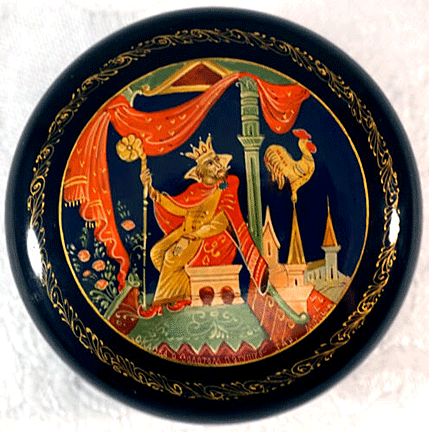 Boxes
produced in the village of Mstyora featured "creamy" earth tones.
Artists often used pale blue, pink, and orange colors for the
background. They liked to paint characters from real life, folklore, and
literary and historical works. Faces of people painted in Mstyora style
tend to have a cartoon feel. Boxes
produced in the village of Mstyora featured "creamy" earth tones.
Artists often used pale blue, pink, and orange colors for the
background. They liked to paint characters from real life, folklore, and
literary and historical works. Faces of people painted in Mstyora style
tend to have a cartoon feel.
Artists drew a preliminary sketch outlined in white lead before starting
to paint a box with egg tempera. After they completed the painting on a
box, they applied gold leaf for highlights. Then they polished the box
with a wolf's tooth. For a distinctive sheen, they lacquered the
finished box is lacquered again. The artist's paintbrushes were handmade
from squirrel hairs. The cooperatives identify the finished boxes by the
artist's name, the village, the painting's title, and a control number.
How to Tell If a Box is Authentic
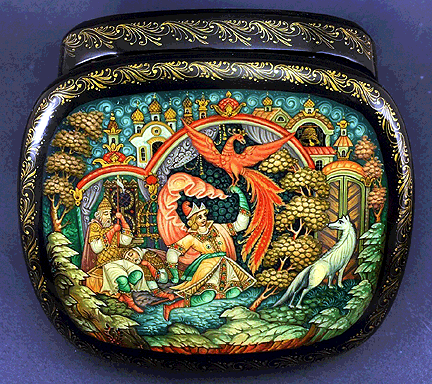 Tourist
guides frequently tell their tour groups that a signature on the bottom
of the box indicates that a master painted it. However, in reality most
lacquer boxes came from small factories where signing another artist's
name was no more difficult than painting in his style. Instead of
checking for the signature of an artist, buyers should consider the
quality and detail of the artwork_ Many of the lacquer boxes produced in
the former Soviet Union have exceptional detail and command astronomical
prices, yet have no signature. Box sellers rather then the artists
themselves have perpetuated the signature myth of the signatures. Tourist
guides frequently tell their tour groups that a signature on the bottom
of the box indicates that a master painted it. However, in reality most
lacquer boxes came from small factories where signing another artist's
name was no more difficult than painting in his style. Instead of
checking for the signature of an artist, buyers should consider the
quality and detail of the artwork_ Many of the lacquer boxes produced in
the former Soviet Union have exceptional detail and command astronomical
prices, yet have no signature. Box sellers rather then the artists
themselves have perpetuated the signature myth of the signatures.
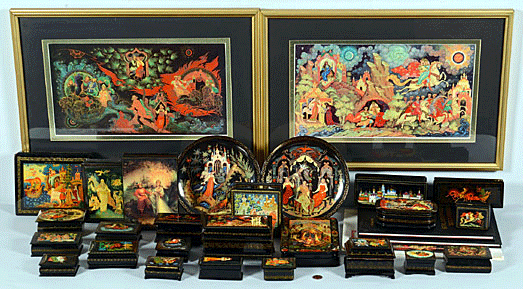
Collectors vigorously seek these little boxes. As a result, untrained
people are now producing them using inferior materials such as wood,
poured acrylic, or pressed sawdust-board called argalite. Tourists find
these on the streets of the tourist centers of Russia and through venues
like eBay. Many of these fakes have the name of one of the four villages
and even the name of a well known artist added to fool the uneducated
buyer. Buying from reputable dealers ensures that any purchase made will
be of high quality, even if the price is higher.
<
Back to Caring for Your Collections
Archives Next
Article >
|
